| Origin | Long head: Ischial tuberosity Short head: Linea aspera and the lateral supracondylar line of the femur |
| Insertion | Long & short head: Lateral head of fibula |
| Action | Long & short head: Knee flexion and lateral rotation of leg Long head: Hip extension |
| Nerve | Long head: Tibial division of sciatic nerve (L5, S1, S2) Short head: Common fibular division of sciatic nerve (L5, S1, S2) |
| Artery | Deep femoral artery (profunda femoris artery) and its perforating branches |
Location & Overview
The biceps femoris muscle is situated in the posterior compartment of the thigh and is one of the three muscles that form the hamstring muscle group. The other two hamstring muscles are the semimembranosus and semitendinosus muscles. The biceps femoris is unique among the hamstring muscles as it has two heads, a long head and a short head. These two muscle heads work together to contribute to its functions discussed in the actions section below [1] [2].
The long head of the biceps femoris muscle is located medially, while the short head is located laterally. The muscle is located superficially in the posterior part of the thigh, with the semimembranosus and semitendinosus muscles positioned medially to it. The biceps femoris muscle runs along the lateral side of the thigh and can be easily palpated on the back of the leg when the knee is flexed. The long head of the biceps femoris muscle crosses both the hip and knee joints, allowing it to participate in movements at both joints. In contrast, the short head only crosses the knee joint, limiting its involvement to actions at just the knee joint [3] [4].
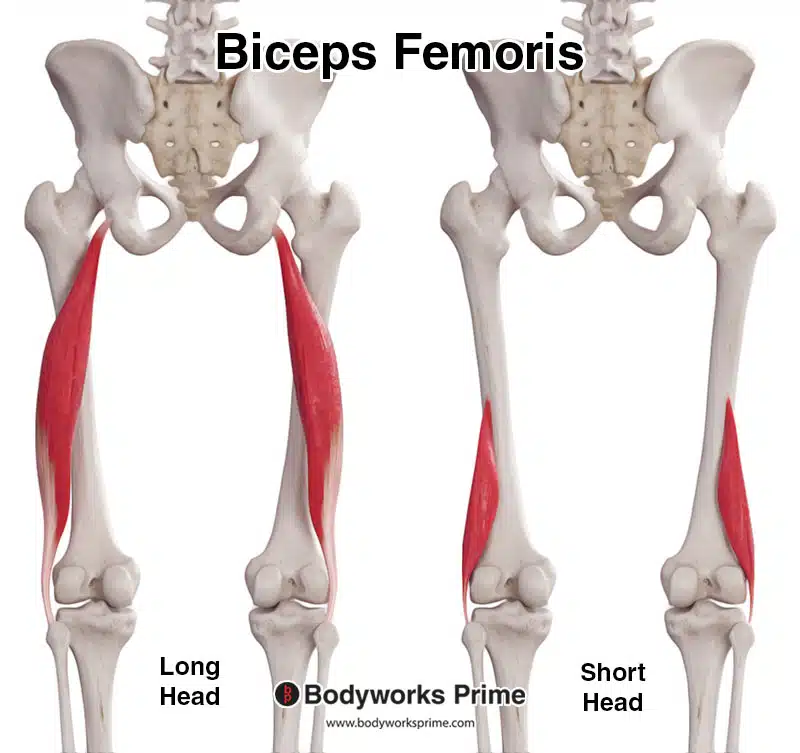
Here, we can see the long head and short head of the biceps femoris muscle, presented from a posterior view. The long head is on the left, and the short head is on the right. The reason for showing them separately is that the short head is deep to the long head, meaning the long head would cover most of the short head if we were to view them together. Scroll down to the lateral view to see them together.
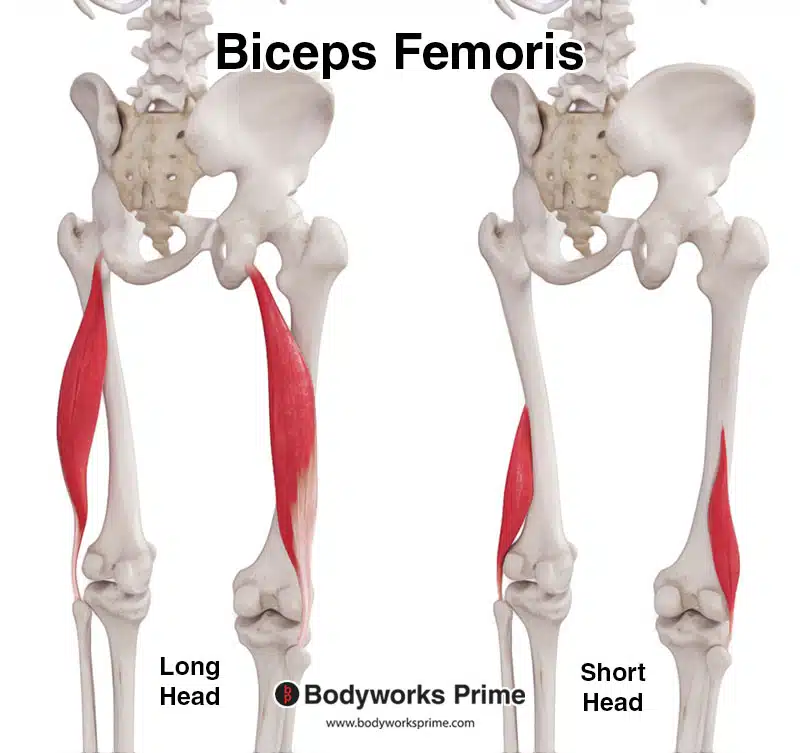
Here we can see the biceps femoris muscle’s long head and short head, seen from a posterolateral view.
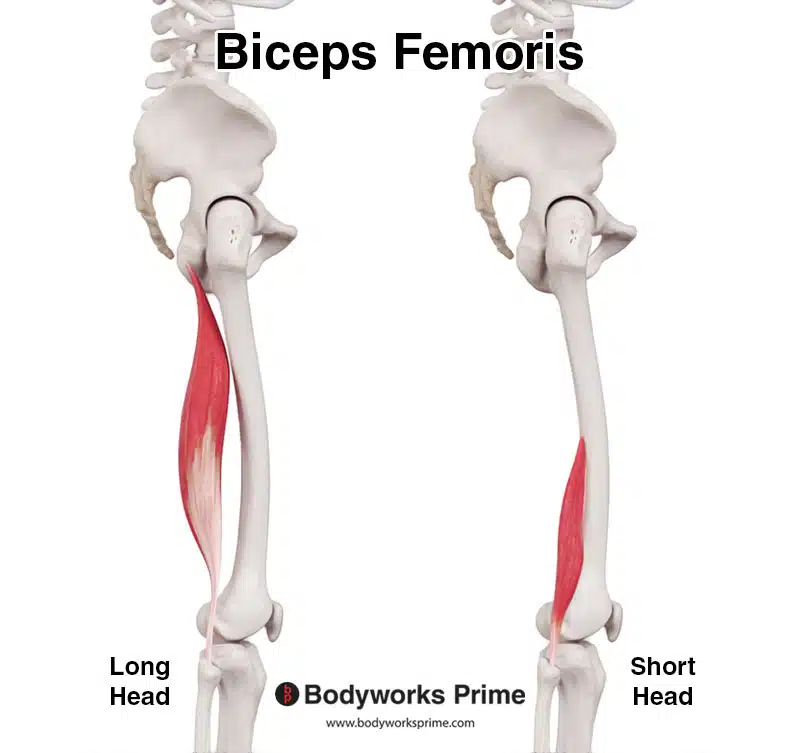
Here we can see the biceps femoris muscle’s long head and short head, seen from a lateral view.
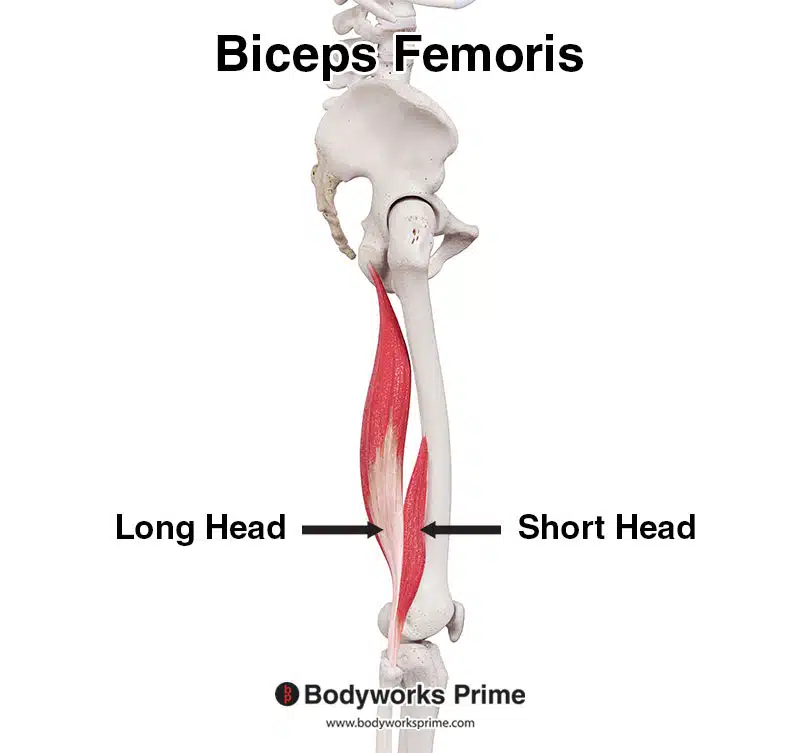
Here we can see the biceps femoris muscle’s long head and short head shown together, and seen from a lateral view.
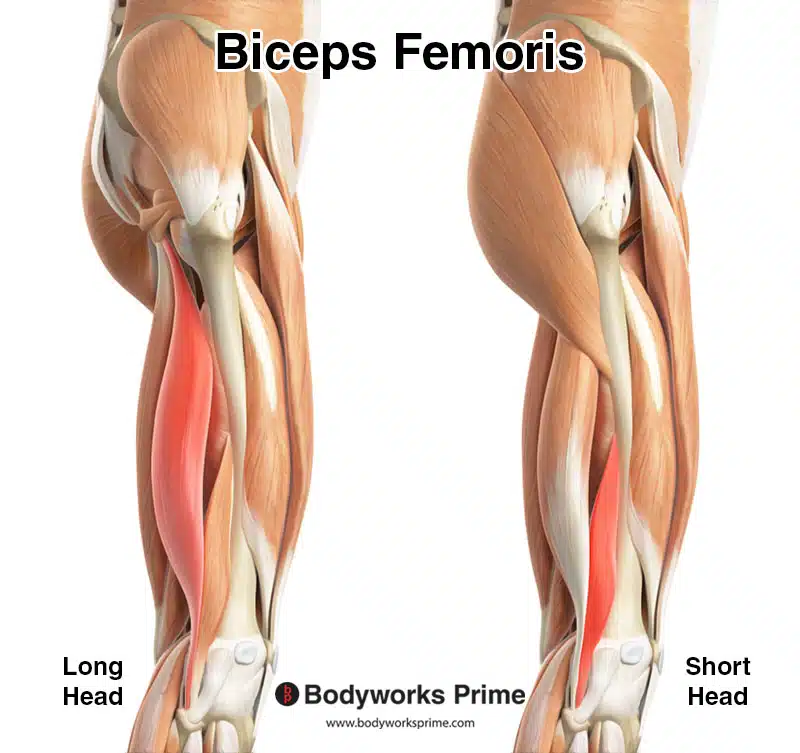
Here we can see the biceps femoris muscle’s long head and short head highlighted in red, seen from a lateral view. This image demonstrates the location of the long and short head relative to each other. The short head is deep to the long head. Muscles which are superficial to the biceps femoris from this view have been removed (such as the tensor fasciae latae and the iliotibial band), to better show its location.
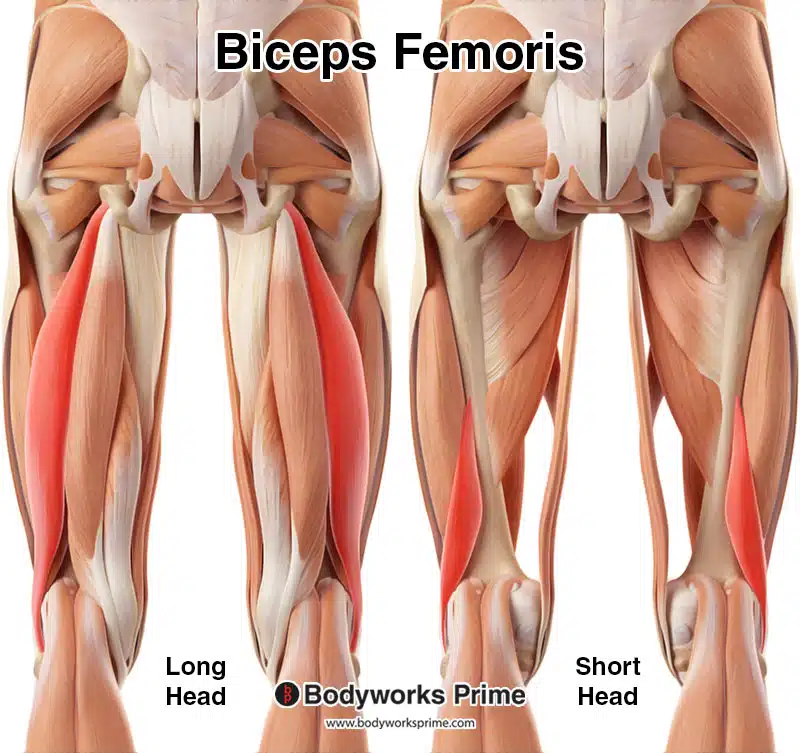
Here we can see the biceps femoris muscle’s long head and short head highlighted in red, seen from a posterior view. This image also demonstrates the location of the long and short head relative to each other. The short head is deep to the long head. Superficial muscles such as the gluteus maximus have been removed, as not to obscure the biceps femoris.
Here we can see the hamstring muscles from a superficial view. The biceps femoris is one of the hamstring muscles. The other two are the semimembranosus and semitendinosus.
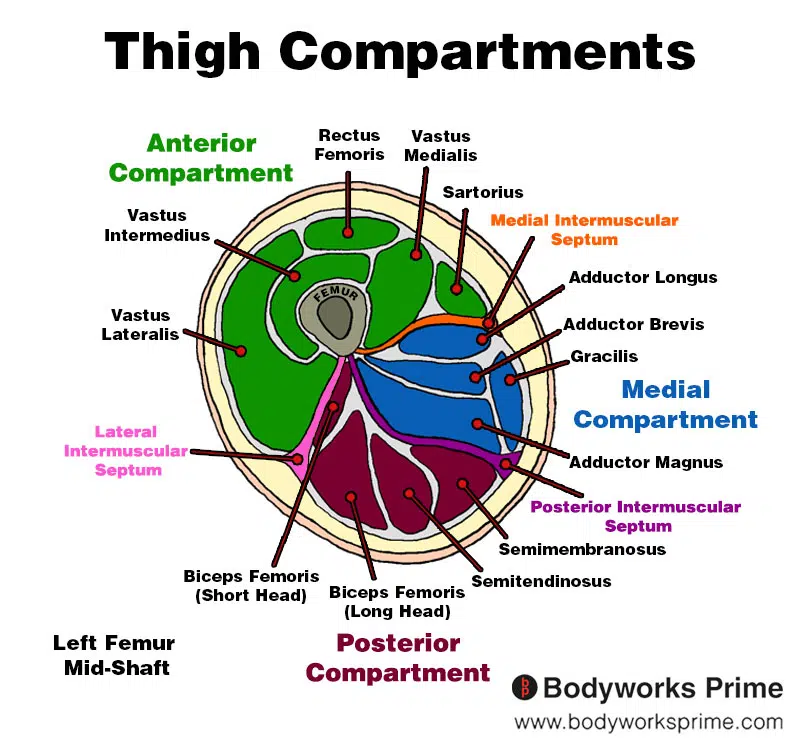
Here we can see an image of the compartments of the thigh. We can see the biceps femoris long and short heads in the posterior compartment, the section coloured in red.
Origin & Insertion
The biceps femoris muscle has two separate origins, one for each of its two heads. The long head originates from the hip’s ischial tuberosity. The ischial tuberosity is bony protrusion located on the posterior aspect of the ischium, which is the lower part of the hip bone. This origin point is shared with the other two hamstring muscles (semimembranosus and semitendinosus) [5] [6]. The short head of the biceps femoris muscle originates from the linea aspera and the lateral supracondylar line of the femur. The linea aspera is a roughened ridge on the posterior shaft of the femur. The lateral supracondylar line extends laterally from the bottom of the linea aspera and it is a ridge found on the lateral, distal and posterior side of the femur [7] [8].
The two heads of the biceps femoris muscle continue down the lateral aspect of the thigh where they insert onto the lateral side of the head of the fibula. The tendon of the biceps femoris muscle is divided at its insertion point by the fibular collateral ligament of the knee (also known as the lateral collateral ligament) [9] [10].
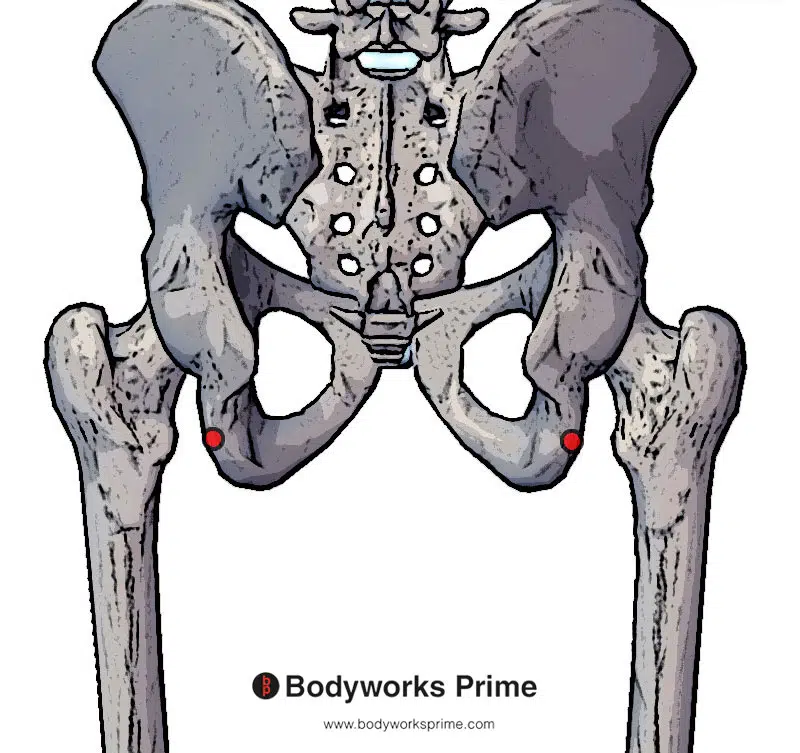
Here we can see the origin of the biceps femoris long head at the ischial tuberosity (marked in red).
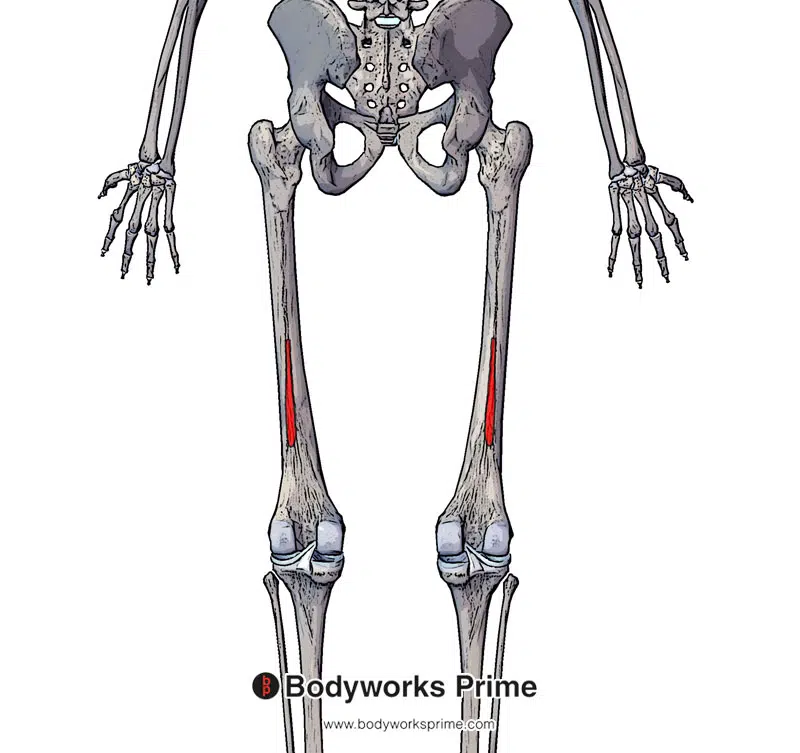
Here we can see the origin of the biceps femoris short head at the linea aspera and lateral supracondylar line of the femur (marked in red).
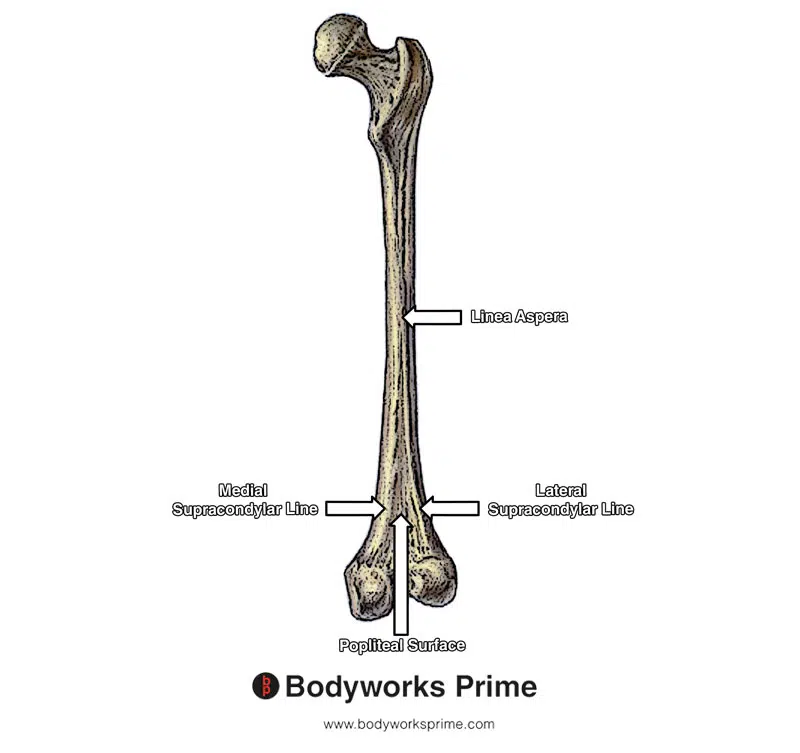
Here we can see a picture identifying the location of the linea aspera and lateral supracondylar line of the femur.
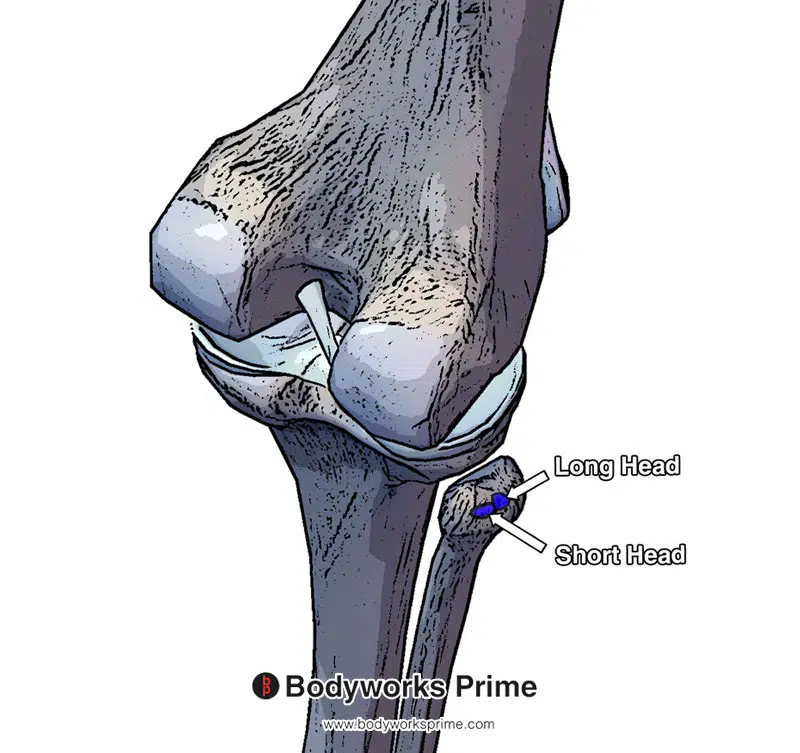
Here we can see the insertion points of the long and short heads of the biceps femoris marked in blue on the lateral head of fibula.
Actions
The biceps femoris muscle contributes to various movements at the hip and knee joints and its two muscular head contribute to different actions. The primary function of both heads of the biceps femoris muscle is to flex the knee joint. Knee flexion involves bending the knee and bringing the lower leg closer to the back of the thigh [11] [12] [13].
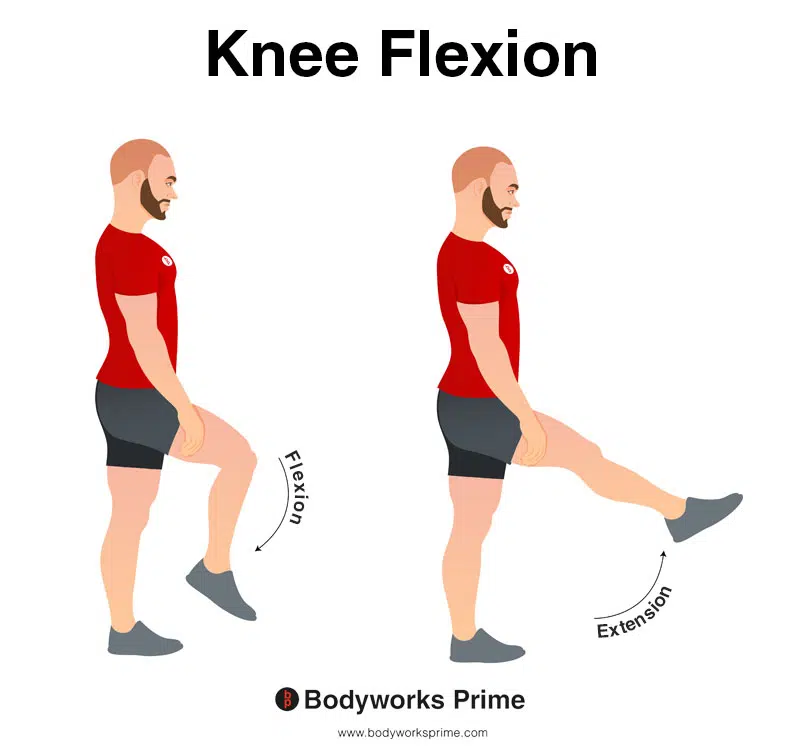
In this image, you can see an example of knee flexion, which is the action of bending your knee. The opposite movement of knee flexion is knee extension. Both the long and short heads of the biceps femoris muscle contribute to knee flexion.
Along with knee flexion, the long head of the biceps femoris muscle also assists in hip extension. This is because it originates from the ischial tuberosity and crosses the hip joint (the short head does not cross the hip joint). Hip extension happens when the thigh moves backward (posteriorly) in relation to the hip, such as pushing off the ground when walking. The long head’s effectiveness in knee flexion and hip extension varies depending on the position of the joints. It is more effective at knee flexion when the hip is flexed and more effective at hip extension when the knee is extended [14] [15] [16].
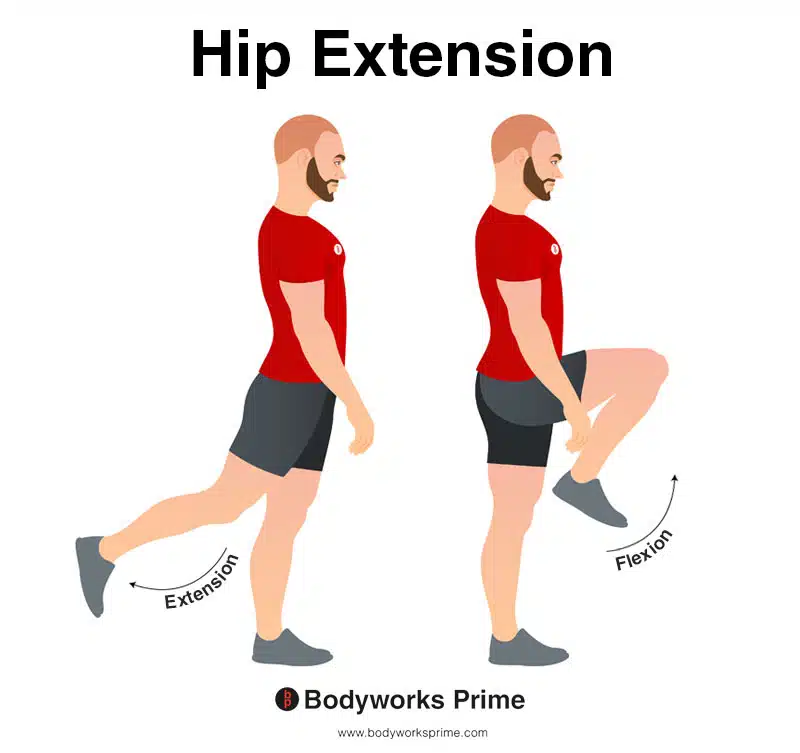
In this image, you can see an example of hip extension. Hip extension is the movement of the thigh or the upper leg backward, away from the body, in the sagittal plane. This action involves increasing the angle between the thigh and the pelvis, causing the hip joint to straighten or extend. The opposite movement of hip extension is hip flexion. Only the long head of the biceps femoris muscle can contribute to hip extension because the short head does not cross the hip joint.
Furthermore, the biceps femoris muscle is involved in lateral rotation of both the femur and the tibia. The long head contributes to lateral rotation of the femur when the hip is extended, while the short head, which only crosses the knee joint, assists in lateral rotation of the tibia when the knee is slightly bent. Lateral rotation, also called external rotation, refers to the outward rotation of the leg relation to the body’s midline [17] [18] [19].
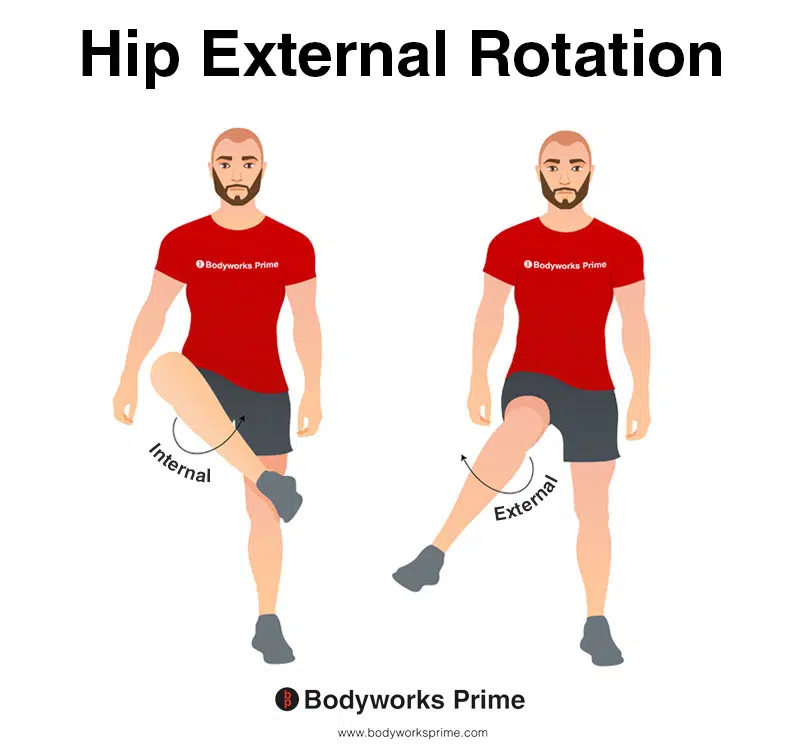
This image depicts an example of hip external rotation, which involves rotating the leg from the hip joint outwards (laterally). External rotation is also referred to as lateral rotation. The opposite of external rotation (lateral rotation) is internal rotation (medial rotation). Only the long head can contribute to external rotation at the hip joint.
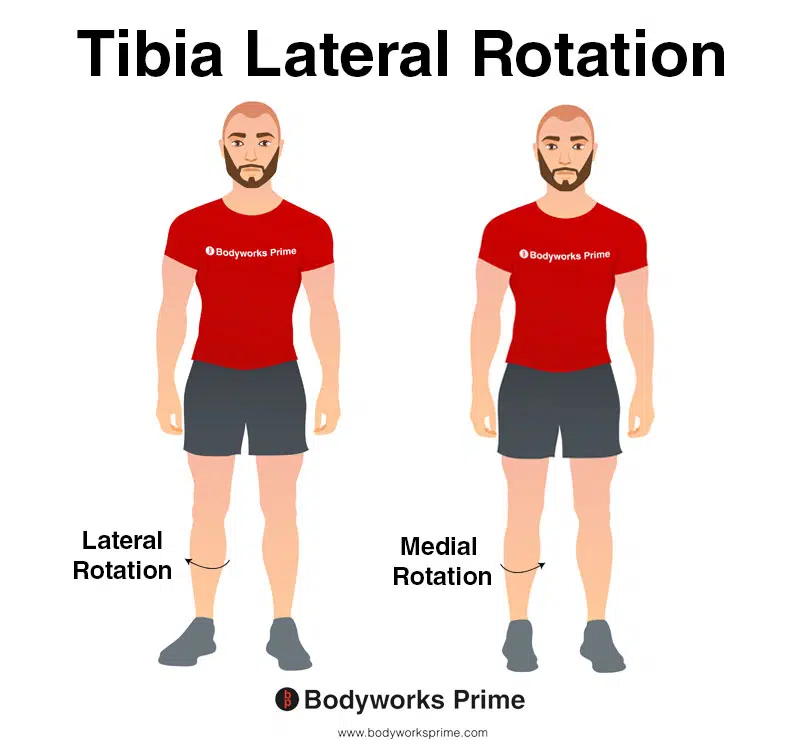
In this image, you can see an example of lateral rotation of the tibia. Lateral rotation of the tibia involves outward rotation of the shinbone away from the midline of the body. The opposite movement of lateral rotation of the tibia is medial rotation of the tibia. The biceps femoris can contribute to lateral (external) rotation of the tibia.
Innervation
The two heads of the biceps femoris muscle are innervated by separate branches of the sciatic nerve. The sciatic nerve is the longest nerve in the human body and starts from the lumbar and sacral spinal nerves of L4 to S3. The long head of the biceps femoris muscle is innervated by the tibial division of the sciatic nerve (L5, S1, and S2). The short head of the biceps femoris muscle is innervated by the common fibular (peroneal) division of the sciatic nerve (L5, S1, and S2) [20].
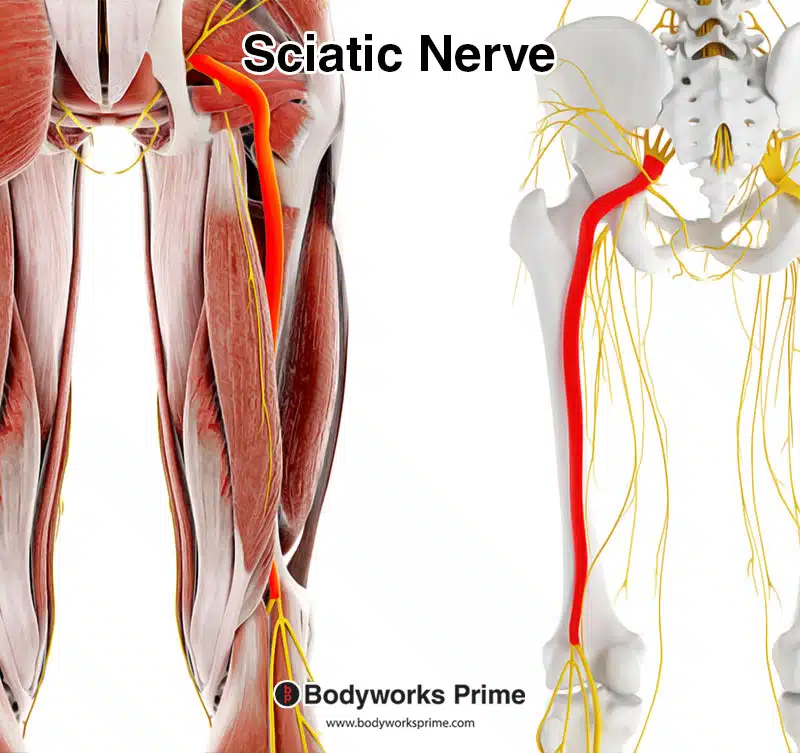
Here we can see the sciatic nerve. Even though the tibial and peroneal nerves separates from the sciatic nerve just above the knee, it’s important to note that the nerves in our body are organised in a network, not in a strictly linear path. The nerve fibers that will eventually form the tibial and peroneal nerves are present within the sciatic nerve from the point at which it leaves the spinal cord. These fibers “travel” within the sciatic nerve and reach the muscles they innervate, including the proximal (top) part of the biceps femoris muscle, long before the physical branching of the tibial and peroneal nerves occur near the knee. Thus, it’s still accurate to say that the biceps femoris is innervated by the tibial and peroneal nerves, even though the physical branching occurs distally.
Blood Supply
The primary blood supply for the biceps femoris muscle is the deep femoral artery (also known as the profunda femoris artery). This artery branches off from the femoral artery and travels deep within the thigh, providing a blood supply to the hamstring muscle group. The biceps femoris muscle also receives blood from the perforating arteries/branches. The perforating arteries are smaller branches which arise from the deep femoral artery [21].
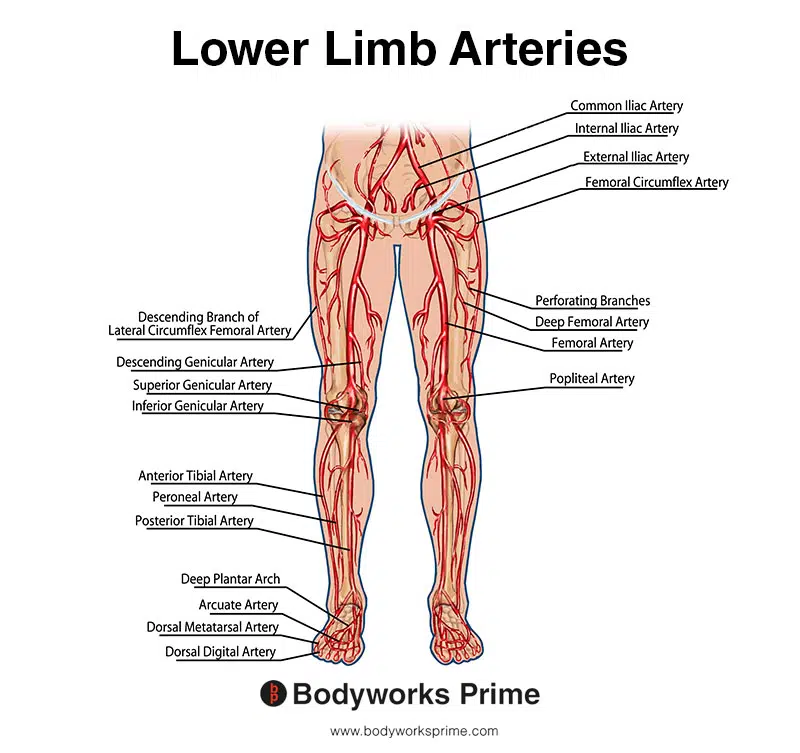
This image shows the arteries of the lower limb.
Want some flashcards to help you remember this information? Then click the link below:
Biceps Femoris Flashcards
Support Bodyworks Prime
Running a website and YouTube channel can be expensive. Your donation helps support the creation of more content for my website and YouTube channel. All donation proceeds go towards covering expenses only. Every contribution, big or small, makes a difference!
References
| ↑1, ↑3, ↑8, ↑10 | Moore KL, Agur AMR, Dalley AF. Clinically Oriented Anatomy. 8th ed. Philadelphia: Lippincot Williams & Wilkins; 2017. |
|---|---|
| ↑2, ↑4, ↑5, ↑13, ↑16, ↑18 | Standring S. (2015). Gray’s Anatomy: The Anatomical Basis of Clinical Practice, 41st Edn. Amsterdam: Elsevier |
| ↑6, ↑7, ↑9, ↑12, ↑15, ↑19 | Rodgers CD, Raja A. Anatomy, Bony Pelvis and Lower Limb, Hamstring Muscle. [Updated 2021 Aug 11]. In: StatPearls [Internet]. Treasure Island (FL): StatPearls Publishing; 2021 Jan-. Available from: https://www.ncbi.nlm.nih.gov/books/NBK546688/ |
| ↑11, ↑14, ↑17, ↑20 | Afonso J, Rocha-Rodrigues S, Clemente FM, et al. The Hamstrings: Anatomic and Physiologic Variations and Their Potential Relationships With Injury Risk. Front Physiol. 2021;12:694604. Published 2021 Jul 7. doi:10.3389/fphys.2021.694604 |
| ↑21 | Tomaszewski KA, Henry BM, Vikse J, Pękala P, Roy J, Svensen M, Guay D, Hsieh WC, Loukas M, Walocha JA. Variations in the origin of the deep femoral artery: A meta-analysis. Clin Anat. 2017 Jan;30(1):106-113. doi: 10.1002/ca.22691. Epub 2016 Feb 2. PMID: 26780216. |










